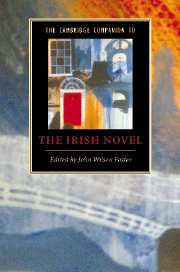Book contents
- Frontmatter
- Introduction
- 1 The novel before 1800
- 2 The national tale and allied genres, 1770s-1840s
- 3 The novel of the big house
- 4 The Gothic novel
- 5 Catholics and fiction during the Union, 1801-1922
- 6 Irish modernisms, 1880-1930
- 7 James Joyce
- 8 Region, realism and reaction, 1922-1972
- 9 The novel in Irish
- 10 Women novelists, 1930s-1960s
- 11 Two post-modern novelists: Samuel Beckett and Flann O’Brien
- 12 Life writing in the twentieth century
- 13 The novel and the Northern Troubles
- 14 Contemporary Irish fiction
- Index
8 - Region, realism and reaction, 1922-1972
Published online by Cambridge University Press: 28 January 2007
- Frontmatter
- Introduction
- 1 The novel before 1800
- 2 The national tale and allied genres, 1770s-1840s
- 3 The novel of the big house
- 4 The Gothic novel
- 5 Catholics and fiction during the Union, 1801-1922
- 6 Irish modernisms, 1880-1930
- 7 James Joyce
- 8 Region, realism and reaction, 1922-1972
- 9 The novel in Irish
- 10 Women novelists, 1930s-1960s
- 11 Two post-modern novelists: Samuel Beckett and Flann O’Brien
- 12 Life writing in the twentieth century
- 13 The novel and the Northern Troubles
- 14 Contemporary Irish fiction
- Index
Summary
Irish regionalism
'Regionalism' is a topical theme, kept before us by the regional policies of the European Union, of which Ireland is a member, and by recent discussions of regionalism in connection with the contemporary phenomenon of economic globalisation. But the concept of 'region' or 'regionalism' in Irish fiction is not straightforward, either before or after the establishment of Northern Ireland and the Irish Free State in 1920-2. Within the tradition of regional fiction in English, Maria Edgeworth made a pioneering contribution with her Irish novel Castle Rackrent (1800), and this was generously acknowledged by Sir Walter Scott, who helped to pass on the lessons to subsequent regional writers. But Edgeworth's example did not of itself produce strongly localised Irish fiction. The main market for Irish fiction has always been outside Ireland, and from the outset this rather discouraged a regional or sub-regional specificity which would not be appreciated at a distance. In consequence, the whole of Ireland, or at least rural Ireland, tended to be identified as a single non-metropolitan 'region', the literary province of nineteenth- and indeed twentieth-century Irish writers in English, just as a largely undifferentiated Scotland tended to be seen as a single region, the province of Scottish writers.
- Type
- Chapter
- Information
- The Cambridge Companion to the Irish Novel , pp. 153 - 170Publisher: Cambridge University PressPrint publication year: 2006
- 1
- Cited by



